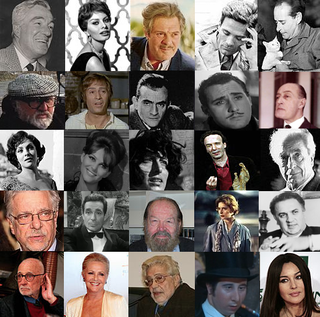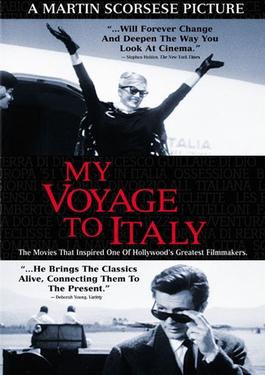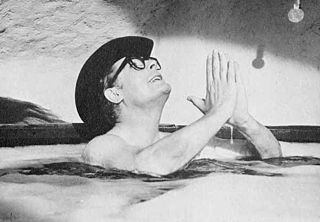Related Research Articles

The cinema of Italy comprises the films made within Italy or by Italian directors. Italy is widely considered one of the birthplaces of art cinema, and the stylistic aspect of Italian film has been one of the most important factors in the history of Italian film. As of 2018, Italian films have won 14 Academy Awards for Best Foreign Language Film as well as 12 Palmes d'Or, one Academy Award for Best Picture and many Golden Lions and Golden Bears.

Italian neorealism, also known as the Golden Age of Italian Cinema, was a national film movement characterized by stories set amongst the poor and the working class. They are filmed on location, frequently with non-professional actors. They primarily address the difficult economic and moral conditions of post-World War II Italy, representing changes in the Italian psyche and conditions of everyday life, including poverty, oppression, injustice and desperation. Italian Neorealist filmmakers used their films to tell stories that explored the contemporary daily life and struggles of Italians in the post-war period. Italian neorealist films have become explanatory discourse for future generations to understand the history of Italy during a specific period through the storytelling of social life in the context, reflecting the documentary and communicative nature of the film. Some people believe that neorealistic films evolved from Soviet montage films. But in reality, compared to Soviet filmmakers describing the people's opposition to class struggle through their films, neorealist films aim to showcase individuals' resistance to reality in a social environment.

Silvana Mangano was an Italian film actress. She was one of a generation of thespians who arose from the neorealist movement, and went on to become a major female star, regarded as a sex symbol for the 1950s and '60s. She won the David di Donatello for Best Actress three times – for The Verona Trial (1963), The Witches (1967), and The Scientific Cardplayer (1973) – and the Nastro d'Argento for Best Actress twice.

My Voyage to Italy is a personal documentary by acclaimed Italian-American director Martin Scorsese. The film is a voyage through Italian cinema history, marking influential films for Scorsese and particularly covering the Italian neorealism period.

Paolo Sorrentino is an Italian film director, screenwriter, and writer. He is considered one of the most prominent filmmakers of Italian cinema working today. He is known for visually striking and complex dramas and has often been compared to Federico Fellini and Michelangelo Antonioni. He has received numerous accolades including an Academy Award, BAFTA Award, two Cannes Film Festival prizes, four Venice Film Festival Awards and four European Film Awards. In Italy he was honoured with eight David di Donatello and six Nastro d'Argento awards.
The Nastro d'Argento is a film award assigned each year, since 1946, by Sindacato Nazionale dei Giornalisti Cinematografici Italiani, the association of Italian film critics.

Franco Fabrizi was an Italian actor.

Furio Scarpelli, also called Scarpelli, was an Italian screenwriter, famous for his collaboration on numerous commedia all'italiana films with Agenore Incrocci, forming the duo Age & Scarpelli.

Franco Interlenghi was an Italian actor.
The Centro Sperimentale di Cinematografia, also referred to as the Scuola Nazionale di Cinema, is an Italian national film school headquartered in Rome, with satellite educational hubs in five other Italian regions.
The Nastro d'Argento is a film award assigned each year, since 1946, by Sindacato Nazionale dei Giornalisti Cinematografici Italiani, the association of Italian film critics.
The Nastro d'Argento is a film award assigned each year, since 1946, by Sindacato Nazionale dei Giornalisti Cinematografici Italiani, the association of Italian film critics.

Osvaldo Desideri was an Italian art director, production designer, and set decorator. He won an Academy Award in the category Best Art Direction for the film The Last Emperor.

The list of the 100 Italian films to be saved was created with the aim to report "100 films that have changed the collective memory of the country between 1942 and 1978". Film preservation, or film restoration, describes a series of ongoing efforts among film historians, archivists, museums, cinematheques, and non-profit organizations to rescue decaying film stock and preserve the images they contain. In the widest sense, preservation assures that a movie will continue to exist in as close to its original form as possible.
The Nastro d'Argento is a film award assigned each year, since 1948, by Sindacato Nazionale dei Giornalisti Cinematografici Italiani, the association of Italian film critics.

Fabrizio Gifuni is an Italian stage, film and television actor. He won two Silver Ribbons and two David di Donatello Award.
Dario Cantarelli is an Italian actor.
Valia Santella is an Italian screenwriter and film director.
Gianfelice Imparato is an Italian actor, playwright and stage director.
References
- ↑ Enrico Lancia. I premi del cinema. Gremese Editore, 1998. ISBN 88-7742-221-1.
- ↑ Tad Bentley Hammer. International film prizes: an encyclopedia . Garland, 1991. ISBN 0824070992.
- ↑ "Awards for Federico Fellini". imdb.com.
- ↑ "Awards for Luchino Visconti". imdb.com.
- ↑ "Awards for Gianni Amelio". imdb.com.
- ↑ "Nastri d'Argento 2024, ecco tutti i vincitori". Adnkronos. 8 July 2024. Retrieved 5 August 2024.